|
|
|
| |
|
| |
|
The term pre menopause
is refered to the entirety of a woman's life from the first to her last regular menstrual period. Therefore, pre menopause is best defined as a time of "normal" reproductive function in a woman leading into the stage of menopause called perimenopause. |
|
| |
In order to understand what happens to a woman's reproductive system as she grows older, it is helpful to review the "normal" reproductive function during pre menopause, which helps a woman's body to prepare for the possibility of pregnancy each month.
The Menstrual Cycle
The parts of the body mainly involved in the menstrual cycle include the brain, the uterus and the ovaries. The communication between these organs is realised by chemical substances, called hormones. For the menstrual cycle the most important hormones are: |
 > FSH (Follicle Stimulating Hormone) > FSH (Follicle Stimulating Hormone)
> LH (Luteinizing Hormone)
> Estrogen
> Progesterone.
|
The beginning of a woman's menstrual cycle takes place in the brain.
The hypothalamus, a part of the brain, involved in controlling the release of hormones from the pituitary gland, produces GnRH (Gonadotropin-releasing hormone).
The GnRH stimulate the pituitary gland to secrete the hormone FSH (Follicle Stimulating Hormone), that as its name suggests, stimulates the development and maturation of follicles, a small fluid-filled balloon-like area in the ovary, where an egg develops.
|
|
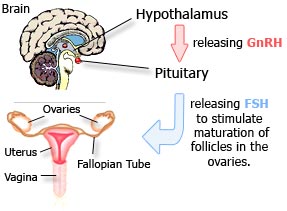
|
|
Each ovary contains from 200,000 to 400,000 follicles. Stimulated by FSH, one of these will become dominant and starts growing.
While developing, this follicle begins to produce a huge amount of estrogen.
|
|
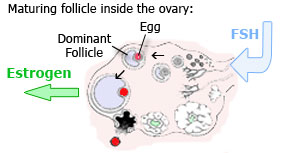
|
|
The produced estrogen causes the lining of the uterus (endometrium) to grow and thicken in preparation of implantation of a fertilized egg.
In addition to that, estrogen suppresses the further secretion of FSH, to stop the stimulation of another follicle.
Estrogen also stimulates the hypothalamus to produce GnRH again, which now signals pituitary gland to secrete a surge of the hormone LH (Luteinizing Hormone).
|
|
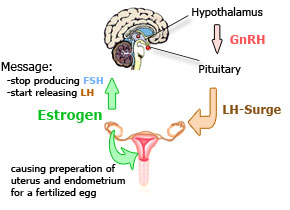
|
|
At about mid-cycle this LH surge, which is accompanied by a transient rise in body temperature, causes the ovary to release enzymes that make a hole in the sac of the dominant follicle, causing it to rupture and release the egg into the fallopian tube where it can be fertilized. This is ovulation.
After ovulation estrogen drops dramatically and the follicle's walls collapse. The dominant follicle, transformed by LH, becomes the corpus luteum after ovulation and begins secreting large amounts of progesterone, which helps prepare the lining of the uterus for implantation of the fertilized egg.
|
|
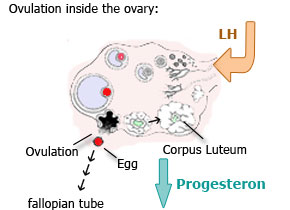
|
|
If the egg is fertilized the production of progesterone and some estrogen is kept and the development of the lining of the uterus continues. As the pregnancy progresses, hormone production is taken over by the placenta.
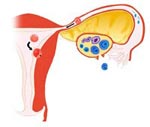
Pregnancy:
|
|
If the egg is not fertilized, the corpus luteum causes the levels of progesterone and estrogen to drop. Without these hormones the uterus soon sheds its lining, and menstruation begins. In addition, with no estrogen to suppress it, FSH levels again start to rise and a new cycle begins. 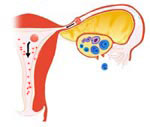
Menstruation:
|
|
|
|
| |
It is the balance and interplay between these hormones which regulate the specific events of a "normal" menstrual cycle during pre menopause. In the following picture the relations between hormones, ovulation and the preperation of the lining of the uterus are shown.
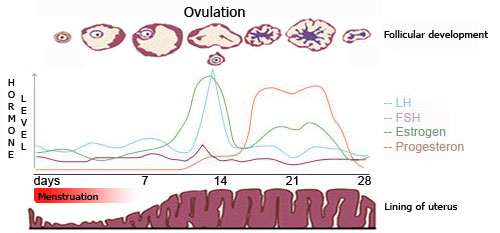
This "normal" reproductive function continues to 35 - 40 years of age. At the end of this period, also known as late pre menopause, the ovaries gradually begin to produce less
estrogen and progesterone and consequently for the most women the first typical symptoms of menopause appear. Falling estrogen and progesteron levels finally lead into the next stage of menopause called perimenopause.
|
Pre menopause is often misused to mean premature menopause , a relatively rare
phenomenon in which menopause occurs before the age of 40. That isn't pre menopause. |
Premenopause >>> Perimenopause >>> Menopause >>> Postmenopause |
|
|



